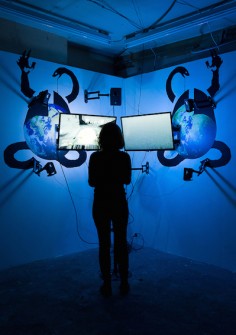viktor timofeev
proxyah
source: viktortimofeev
Proxyah is an installation which centers around a 2-channel “closed-world” computer game. It was built using the Unity game development engine, during an artist residency at Jupiter Woods, London.
.
.
.
.
.
.
.
source: aqnb
“You are in this three-dimensional room”, says the exhibition sheet of Viktor Timofeev’s Proxyah v2 running at London’s Jupiter Woods from January 9 to February 8. It’s the first line of some rather complicated instructions outlining how its user should navigate the unstable CGI setting of the ‘Proxyah v2’ (2015) video game, screening on the left of a two-channel installation in the far-left corner of the Bermondsey space. The blue darkened room gives off the aura of being underwater, the staircase to the right and the sheet of fabric blocking the back kitchen effects an eerie sense of the parasitic. It’s as though this highly complex contraption shouldn’t be there, but it is and it’s sucking the life out of a building that’s falling away around it.
The real infrastructure is on the screen, except that it’s a construction that’s equally as precarious. The sense of groundlessness is literal as the computer-generated water-level rises with every step inside the screen, those steps being complicated by the fact they’re being led by a joystick, shaped like an egg and nestled in a square of astroturf. It’s disorienting in the fact that the compass of the onscreen HUD (ie: heads-up display) changes depending on its colour and the alignment of the room. The ‘room’ itself is a thing made of animated walls, floor, a ceiling, that shift and change within a uniquely terraformed landscape generated by the user’s own movements – those movements being determined by the ever-changing space and the focus of its user. The user’s energy expenditure is constantly being counted.
I’m not going to try to explain the rules of ‘Proxyah v2’, but I also don’t think they’re exactly the point. Coded by computer science course drop-out Timofeev and inspired in part by his experience of an insurmountable set of directions determining the movements of Yvonne Rainer’s ‘Diagonal’ (1963), performed at Raven Row last year, I will say that there’s a powerful sense of helplessness that endures. As one tries to navigate their way through the codes, symbols and invisible systems of Proxyah, the multiple speakers scattered across the room and engulfing its user detect and announce your every move with a blast. A second screen shows an unsettlingly smooth (and silent) perspective of an autonomous object as it hovers above an ocean of stock sea water taken from the Unity game engine on which ‘Proxyah v2’ was built.
As a user, you’re likely to have combat flight on the mind, as one of two snakes of the aerial map – resembling a regular default phone setting Snake game – on the interactive screen is called “drone”, as opposed to the randomly moving “rogue”. The drone’s path is predetermined and the user’s ability to control this omniscient viewpoint is non-existent as it scans a sea engulfing the same white orbs of energy integral to the gameplay. The interactive screen of Proxyah feels like chaos in contrast to this vision of peace that sways lightly beside it, except it’s not you, the user, that controls it. *
.
.
.
.
.
.
.
source: beautifuldecay
Victor Timofeev literally fell into drawing a few years ago after a horrid skateboarding accident and began using art to pour out frustrations that were simmering inside. Since then he has developed an amazing vocabulary incorporating perspectival, architectural and geometric patterns that engulf a space with sharp precision and confounding visual illusions. Where his earlier work incorporated obsessive and repetitive text as the base for color and form, he now builds a platform where physical and architectural objects plunge into geometric abstraction and the two forces coerce into infinite and poetic narrative.
In a recent series, Victor uses the Rubik’s cube as a point of departure, dissecting, rearranging and compartmentalizing a signature brain teaser object. He uses it to unconventional means and incorporates its rich color field and appropriates modernist abstraction with the everyday. The resulting combination gives you a refreshing new perspective and understanding of personal memories and art history.
For one year the artist drew daily architectural studies from life, books, and memory and proceeded to deconstruct each building and its environment, skewing and exaggerating perspectives, ultimately tranforming and making each object his own. This sense of ownership releases a breathing energy through each corner, nook and cranny, stirring a strange empathy where only a deadened silence would exist.
Victor Timofeev was born in 1984, received his BFA at Hunter College and currently lives and works in Berlin. He is represented by Hannah Barry Gallery and Schmidt & Handrup.


